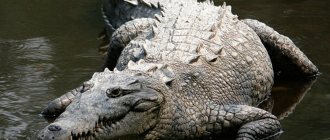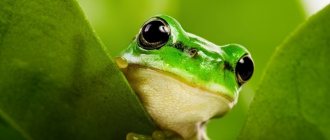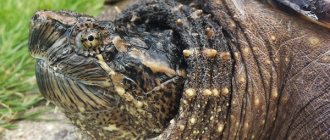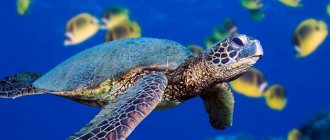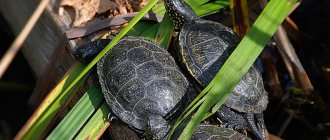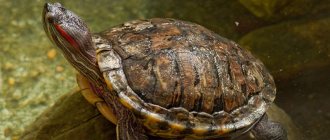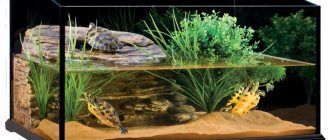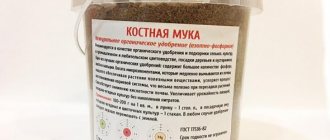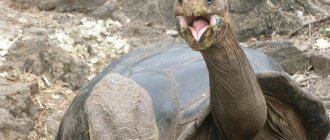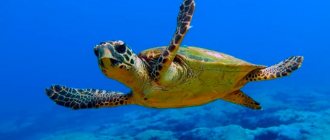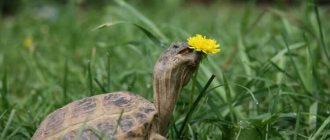The turtle is rightfully considered one of the most interesting orders of reptiles. Scientists who studied ancient remains in order to find out how many years she had been living on the planet found that their existence on Earth lasted more than 220 million years. These are rare animals that can live on land and in water. The turtle is a reptile that has 328 species, grouped into 14 families.
External and internal structure
When you hear the word “snake,” goosebumps run across your skin and a feeling of disgust arises. Even animals behave excitedly when meeting snakes. These animals are always surrounded by some kind of mystery. There were legends, myths and various beliefs about them. They have long been used in various symbolism. For example, a cobra was depicted on the pharaoh’s headdress as a symbol of power and invincibility.
The medical emblem is a cup with a snake entwined around it, and it is called the “Hippocratic Cup.”
Symbol of medicine - a bowl with a snake
Look at the ambivalent attitude people have towards snakes, representatives of reptiles.
In the 18th century, reptiles and amphibians were grouped together under the general name "reptiles." If these two classes were grouped together, then they probably have common features.
In order to understand who reptiles are and form our attitude towards them, today we will devote a lesson to these mysterious animals.
There are currently approximately 8,000 species of reptiles. The origin of the word “reptile” is from the Greek word “reptare” - to crawl on the belly.
The general structure of reptiles is reminiscent of the tailed amphibians that we met in the previous lesson. In terms of external structure, reptiles present a wide variety:
Snakes have a long, thin body without limbs;
Collared snake
Lizards are characterized by short limbs on the sides of the body and a long tail;
Fast lizard
Turtles can be recognized by their wide, flat body, covered in a bony shell.
Mediterranean turtle
What common features, despite external diversity, can be identified in the structure of reptiles?
The skin is represented by horny scales, which differ in size among different species. Let's get acquainted with the structure of the integument of reptiles in the figure.
The horny scales form a dense covering that prevents body growth. Therefore, throughout their lives, reptiles “shed” their skin several times, that is, the process of molting occurs.
The molting process can vary among different species of reptiles. Lizards and snakes “shed” their entire skin. The animal rubs against all sorts of objects, and the skin moves off the body in the form of a “stocking.”
Snake shedding
In other species of reptiles, molting is a slow sloughing of the upper layers of the skin.
In the external structure of the body of reptiles, three sections can be distinguished: head, torso and tail. Some species have limbs with claws - front and rear. Various sense organs can be seen on the head.
Let's move on to the internal structure of reptiles, which has features similar to amphibians. Although there are certain differences.
The structure of the reptile skeleton has its own characteristics. Like amphibians, the skeleton is divided into three sections: the skull, the spine and the skeleton of the limbs. The exception is snakes - they have no limbs.
A distinctive feature of the structure of the reptile skeleton is the large number of vertebrae. For example, lizards have no more than a hundred vertebrae, and snakes have up to four hundred.
The ribs are well developed and a rib cage appears, which protects the internal organs.
The digestive system of reptiles is similar in structure to amphibians. You can get acquainted with the digestive organs in the figure.
A special feature of the structure of the reptile’s digestive system is the presence of teeth.
The circulatory system is also in many ways similar to amphibians. The difference is the complex structure of the reptile heart, which is associated with constant pulmonary respiration. Lizards, snakes and turtles have a 3-chambered heart, but crocodiles have a 4-chambered heart.
The nervous system is represented by the spinal cord and brain. In many ways it corresponds to the nervous system of amphibians.
Complications can be seen in the structure of the reptile brain. For example, reptiles have a well-developed cerebellum, which can be seen in the figure. The main reason for this is the good mobility and varied movements of the animals.
Reptiles do not have cutaneous respiration because they breathe using their lungs. The structure of the lungs in reptiles is complicated.
Despite the complex structure of the heart and lungs, metabolism in the body of reptiles occurs rather slowly. Therefore, body temperature is variable and fluctuates throughout the day. Reptiles and amphibians can be considered cold-blooded animals.
Comparison
Skin covering
For reptiles, the connection with water is not so important. They often settle in dry and hot areas. Scaly skin protects the animal's body from drying out. In turtles, the shell, which serves as shelter from faster pursuers, also consists of fused scales. Reptiles molt periodically. The skin is shed all at once or in parts. Thanks to this, the scales do not hinder the growth of the animal.
We suggest you familiarize yourself with: Racehorse maintenance and training
The body of amphibians is not covered with scales. Many people are reluctant to touch these creatures because of their wet and slippery skin. It's all about the glands that produce mucus, which literally permeate the skin of animals.
Structure of organs
The difference between reptiles and amphibians is that the former have more advanced physiology. Their nervous system is complicated. Hearing, vision and other senses are quite developed. Reptiles are born with already formed lungs, while the larvae of amphibians have gills.
The structure of the spine in amphibians is simpler - it consists of four sections. The spine of reptiles is represented by five sections. In addition, tailless amphibians lack ribs.
Proper feeding
Turtles of this species eat little. It will be enough to give food every three days. The best diet for a pet turtle is something that is fresh and varied. Since these reptiles are herbivores, their diet should consist of 80% plant foods. To determine the required portion, look at the size of the shell. Conventionally, divide it in half, one half is equal to the correct amount of food.
Advice! Just like people, turtles have individual tastes, so follow your pet's taste preferences and you can find out his favorite food.
So, what can you offer the animal:
- Vegetables: corn, beans, carrots, tomatoes, zucchini.
- Greens: carrot tops, lettuce, cabbage (these products should not be given often, as they may affect the gastrointestinal tract).
- Fruits: apples, grapes, strawberries, melon, banana, kiwi, mango.
- Flowers: geranium, dandelion, lily, carnation.
- Branches of fruit trees: apricot, cherry, pear, apple, peach.
In addition to a variety of foods, the diet should be supplemented with a source of calcium, which is essential for maintaining a strong and healthy shell. Crushed eggshells, oyster shells and cuttlefish are all good sources of calcium that you can add regularly to your turtle's diet.
The Central Asian turtle at home needs feeding. You can offer her the following products (no more than once a week):
- fish;
- bloodworms (larvae);
- special food;
- dry yeast;
- banana;
- seaweed;
- mushrooms;
- cucumber.
It is prohibited to feed the animal with human food (minced meat, meat, bread, eggs), as well as dog or cat food.
Important! Do not give your turtles any dairy products such as milk, yogurt or cheese. Their stomach is not able to digest them. To ensure your turtle eats with appetite, follow these recommendations:
To ensure your turtle eats with appetite, follow these recommendations:
- Offer your pet protein sources just once a week.
- Offer foods chopped into small pieces. Turtles do not have teeth and use their jaws to bite.
- The best food is fresh food. Do not leave food in the terrarium where it can rot. Always wash your food bowl before feeding.
Reptiles drink very rarely, so having a sippy cup in the terrarium is not necessary. An animal can turn it over, trample it, and spilled liquid will increase the humidity in the “turtle house.”
You can’t forbid living long
One form of natural selection is called positive because it tends to fix traits that are beneficial to the population. As evidence of positive selection in the evolution of giant tortoises, a group of geneticists from different countries identified 43 genes [3]. These include:
- AHSG takes part in the process of capturing hydrophilic molecules necessary for cell life, brain development and bone tissue formation.
- TDO2 encodes an enzyme that plays an important role in tryptophan metabolism. Let me remind you that it is from tryptophan that serotonin is formed in the human brain.
- MVK is involved in the synthesis of an enzyme that promotes the formation of cholesterol (it produces steroid hormones and bile acids necessary for normal development and digestion of fats, respectively). This enzyme also helps produce substances used in cell differentiation, cytoskeleton formation, etc.
Although rarely detected, positive selection plays an important role for geneticists, as it may indicate recent duplication of precursor genes, which led to the emergence of proteins with new functions and structures for a given population.
Mutations in genes affecting metabolism led to a slowdown in metabolic processes, which, in turn, could cause the longevity of these reptiles.
Now let's talk more about metabolism.
The aging process of the body makes it impossible to maintain cellular homeostasis, which leads to disruption of metabolic processes. As you might have already guessed, turtles also have their own “ace in the hole” here, or rather, under the shell.
An interesting discovery was mutations in genes that regulate glucose metabolism and are involved in energy metabolism:
- Duplications of GSK3A (p.R272Q - a variant of the phenotype when arginine (R) at position 272 is replaced by glutamine (Q)), which encodes an enzyme involved in the regulation of the processes of receiving and transmitting information in cells. Involved in maintaining glucose homeostasis. It also regulates the production of peptides that provoke Alzheimer's disease [13].
- GAPDH doubling. It encodes an enzyme that plays a key role in energy production, as well as DNA repair and cell apoptosis [3].
- Absence of the NLN gene. Loss of this gene in mice resulted in more complete glucose uptake and increased insulin sensitivity [14].
Thanks to these changes, turtles are able to maintain their cellular homeostasis over time, allowing them to live happily ever after.
Another distinctive feature of giant tortoises was found in the mitochondria, where two mutations were found - p.Q366M and p.M487T. They affect the functioning of the ALDH2 gene [3]. This gene encodes mitochondrial aldehyde dehydrogenase, which is involved in alcohol metabolism and lipid peroxidation, among other detoxification processes. Interestingly, the p.Q366M mutation, which results in a change in the NAD-binding site of the ALDH2 enzyme, is found exclusively in Galapagos giant tortoises, but not in their continental close relative, the Argentine tortoise. Such changes stimulate the body’s detoxification processes, which again helps to prolong life! Together with changes in the NLN and GAPDH genes, which also encode enzymes associated with mitochondrial function, these mutations may prevent the occurrence of mitochondrial dysfunctions that lead to accelerated aging.
For a genetic analysis of turtle longevity, a group of scientists selected 500 genes that, according to their assumption, could be involved in the aging process [3]. As a result, they identified changes in several genes, the main function of which is to maintain genome integrity (Fig. 6).
- Firstly, this is a duplication of NEIL1 (Fig. 6a), a gene for a key protein involved in base excision repair, which prevents damage to molecules by reactive oxygen species [3].
- Secondly, duplication of RMI2 (Fig. 6a). This gene is necessary for regulating the process of separation of sister chromatids and repairing damage in the DNA molecule [15].
The mechanism for repairing damage to the nitrogenous bases of DNA molecules due to exposure to reactive oxygen species, alkylation, ionizing radiation, etc.
Figure 6. a - Gene duplications and putative sites of change in function found in the Abingdon elephant tortoise, Seychelles giant tortoise and other species. b — Sites identified in XRCC6 and DCLRE1B.
[3], figure adapted
Expression of these two genes leads to a decrease in the amount of proteins involved in DNA strand packaging and the cleavage of poly(ADP-ribose) polymerases (PARP), indicating a decrease in the level of DNA damage. The scientists argue that this result is consistent with the hypothesis that NEIL1 and RMI2 may regulate the strength of DNA repair mechanisms [3].
- Thirdly, a single mutation in XRCC6, a gene encoding an enzyme that is involved in the repair of non-homologous ends of the DNA molecule using the energy of hydrolysis of the ATP molecule, which can affect its functioning (p.K556R) (Fig. 6a) [3]. This protein is present in various vertebrates, but in giant tortoises and naked mole rats it undergoes mutations (p.K556R and p.K556N, respectively), which affect the repair of DNA molecules in long-lived organisms (Fig. 6b). This phenomenon may indicate the presence of convergent evolution between organisms.
- Fourth, a change in the DCLRE1B gene (p.R498C) (Fig. 6a), which, together with TERF2 (Fig. 6b), protects telomeres from non-homologous end joining. This process can result in the formation of chromosomes with two centromeres that break apart during mitosis. Maintaining a certain length of telomeres, without shortening, can be called the “regulatory mechanism of turtle longevity.”
- Fifth, an increase in copies of the EEF1A1 gene. This gene encodes a protein involved in the delivery of amino acids from tRNA to the ribosome during protein biosynthesis [3].
As a result of existing in similar conditions, different organisms can acquire similar characteristics, regardless of their close relationship. For example, organs that perform the same function in different animals acquire the same shape.
In addition, a mutation in the MIF gene can lead to the formation of disulfide bonds that inhibit intracellular signals. A mutation in the IGF1R gene affects the functioning of the growth factors IGF1 and IGF2. In particular, a model of the Abingdon tortoise IGF1R protein showed (Fig. 7) that the amino acid at position 724 is located on the surface of the protein, and the presence of an aspartic acid (D) residue instead of an asparagine (N) residue changes the electrostatic field of the molecule. The unique change in IGF1R, according to scientists [3], may provide material for studying the cellular mechanisms underlying the longevity of these reptiles. Interestingly, the geneticists also discovered a short deletion in the coding region of IGF2R, which results in the loss of two amino acid residues. Given that human IGF2R mutations are associated with longevity, it can be assumed that they have a similar effect in turtles.
Figure 7. Multiple sequence alignment of the IGF1R protein around amino acid 724 in the Abingdon elephant tortoise, Seychelles giant tortoise, and other species. For comparison, simulated human (top right) and Abingdon tortoise (bottom right) IGF1R surfaces are shown around the same area. Negatively charged areas are shown in red, positively charged areas are shown in blue.
[3], figure adapted
Natural enemies of sea turtles
Photo: Green sea turtle
Despite the turtles' natural defense - a strong shell - sea turtles are very vulnerable creatures. Most sea turtles die in early childhood and the mortality rate at this stage is about 90%.
Best articles: Main biomes of the planet
Natural enemies of sea turtles are:
- large sharks;
- fish;
- dogs;
- raccoons;
- seagulls and other birds;
- crabs.
Only sharks are dangerous to adult turtles. Clutches can be destroyed by many predators; on land and in water, juveniles can be attacked by birds, dogs, and predatory fish. During bad weather conditions, many turtle hatchlings often die in turtle breeding areas. They either do not hatch at all due to too low or, conversely, high sand temperatures, or they die after hatching and getting ashore in bad weather.
But the main enemy for sea turtles is humans. People catch sea turtles because the meat of these animals is used for food, and the shell is used to make jewelry, jewelry boxes, and many home decoration items.
Water pollution has a very negative impact on the population of sea turtles. Often, sea turtles mistake garbage and polyethylene and pieces of plastic for edible jellyfish and die due to ingestion of inedible objects. Many turtles get entangled in fishing and shrimp nets, which is why they also die.
Interesting facts about turtles
- Representatives of this order of amphibians can boast that they have left their mark on the history of astronautics. Two individuals of the Central Asian tortoise species were the first among animals to fly around the Moon and return alive to Earth.
- The meat of these animals is a delicacy. But some species are not recommended for consumption. This happens because sometimes this turtle eats poisonous mushrooms or jellyfish. They do not eat the meat of box turtles, leatherback turtles and hawksbill turtles.
- Reptiles of this order can swim well and move on land. But the European tortoise can also be called a jumping tortoise. She can jump into the water from three-meter mountain ledges.
- Turtles have their own long-lived lives. So in 2006, the oldest turtle, Advaita, died, whose age, according to experts, was more than 150 years.
- Many people wonder how long a turtle can live without food. In the natural environment, determining this time is quite difficult. But for pets, this is a maximum of 3 weeks, taking into account the fact that the animal is hibernating. In nature, the sleep period can last several months. It is believed that at this time the reptile does not eat at all.
- During the period of courtship and mating, sea turtles stick their heads out of the water and make drawn-out sounds similar to howls.
Turtle
4 (80%) votes: 11
Origin of reptiles
Fossil reptiles are of great importance because they once dominated the globe and from them came not only modern reptiles, but also birds and mammals.
Living conditions at the end of the Paleozoic changed dramatically. Instead of a warm and humid climate, cold winters appeared and a dry and hot climate established. These conditions were unfavorable for the existence of amphibians. However, under such conditions, reptiles began to develop, whose skin was protected from evaporation, a terrestrial method of reproduction, a relatively highly developed brain and other progressive characteristics appeared, which are given in the characteristics of the class.
Based on a study of the structure of amphibians and reptiles, scientists came to the conclusion that there are great similarities between them. This was especially true for ancient reptiles and stegocephalians.
- In very ancient lower reptiles, the vertebral column had the same structure as in stegocephals, and the limbs - like in reptiles;
- the cervical region of reptiles was as short as that of amphibians;
- the chest bone was missing, i.e. they did not yet have a real chest.
All this suggests that reptiles evolved from amphibians.
general information
Reptiles and amphibians have second names. Reptiles are also called reptiles, and amphibians are called amphibians. The largest animals, dinosaurs, were reptiles. Reptiles once dominated everywhere on Earth. Then most of them died out. The most famous representatives of modern reptiles are crocodiles, turtles, snakes and lizards.
Reptiles
Now let's say who is amphibian. This is a frog, a newt, a salamander. Amphibians are the most primitive vertebrates in their structure. These animals have this name because the important habitat for most of them is land, and the necessary environment for reproduction and development is water. Among amphibians, there are those that spend their lives mainly in water.
Sea turtle conservation
Photo: Sea turtle from the Red Book
Many sea turtles are listed in the Red Book and require special protection measures. Trapping of hawksbill turtles is currently prohibited. In many countries, trade in turtle shells, their eggs and meat is prohibited. Authorities in the Dominican Republic carry out daily raids to identify violators selling products from these animals.
A society for the protection of turtles was also created in the Dominican Republic. They protect the beaches where these animals breed. In order not to scare off the females coming to the beach to form clutches, all the lighting on the beach is red. Any noise during the mating season of turtles is prohibited.
Beaches where turtles breed during mating season are closed to tourists. The clutches are marked with flags; in some countries, zoologists carefully collect the eggs and take them to a nursery, where the eggs are placed in an incubator. Hatched turtles grow in captivity for up to 2 months and are then released into the sea. Also, special GPS sensors are glued to each turtle to track the movement of the animal. In many countries, the export of rare species of turtles is prohibited.
In order to ensure that fewer animals die in fishing nets, fishing nets were modernized by order of the authorities. Thanks to this modernization, tens of thousands of rare species of turtles were saved. However, despite modernization, up to 5 thousand turtles die in nets every year. Most often, turtles get caught in nets in the Gulf of the Sea, where they are fishing for shrimp. Rescuers catch turtles that become entangled in nets or poisoned by garbage and try to help them.
The sea turtle is a very amazing, ancient creature, which is also very hardy. They are real long-livers. However, due to human activity, the population of these animals is on the verge of extinction. Let's take more care of our nature in order to preserve these amazing creatures. We will monitor the cleanliness of reservoirs and protect nature.
Tags:
- Chelonioidea
- African animals
- Deuterostomes
- Bilaterally symmetrical
- Diapsids
- Ancient animals
- Animals of Australia
- Animals of the Atlantic Ocean
- Animals of Belgium
- Animals of Great Britain
- Animals of the Dominican Republic
- Animals of the Indian Ocean
- Animals of Cameroon
- Animals of the Red Book
- Animals of Morocco
- Animals of the seas
- Animals starting with the letter M
- Animals starting with the letter H
- Animals of New Zealand
- Animals of the oceans
- Animals of the Subantarctic belt
- Animals of the Subtropical Zone of the Northern Hemisphere
- Animals of the Subtropical Zone of the Southern Hemisphere
- Animals of the Subequatorial Belt of the Northern Hemisphere
- Animals of the Subequatorial Belt of the Southern Hemisphere
- Animals of Tasmania
- Animals of the Pacific Ocean
- Animals of the tropics
- Animals of the Tropical Zone of the Northern Hemisphere
- Animals of the Tropical Zone of the Southern Hemisphere
- Animals of Turkey
- Animals of the Temperate Zone of the Northern Hemisphere
- Animals of the Temperate Zone of the Southern Hemisphere
- Animals of the Black Sea
- Animals of Scotland
- Animals of Sri Lanka
- Animals of the Equatorial Belt
- Animals of the Sea of Japan
- Interesting animals
- Sea creatures
- Marine life
- sea turtles
- Vertebrates
- Reptiles of the Red Book
- Rare animals
- Rare animals of the world
- The most beautiful animals
- Hidden-necked turtles
- Amazing animals
- Predators
- Chordates
- Ghostostomes
- Turtles
- Quadrupeds
- Eukaryotes
- Eumetazoans
Types of land turtles
This group is the leader in the number of representatives. It includes 37 species of land representatives and 85 freshwater ones. Also, several small families of 1-2 species each can be classified as terrestrial reptiles. They all spread quite widely, occupying space within the tropical, subtropical and temperate zones of the Earth.
Mostly terrestrial turtles are represented by herbivores. They eat any plant food, with which they can receive additional moisture. Indeed, in many habitats of these animals there is usually an arid climate.
If there is a long hot period of drought, reptiles hibernate. They have a slow metabolism, which is why they can live for a long time, for example, up to 150 years or more. Let's look at the two largest families - land and freshwater turtles.
Aquarium compatibility
Trionics are predators. Carnivorous reptiles should not be kept with animals not intended for food. They will eat all aquarium inhabitants, including macropods: it is believed that these fish are able to wean a soft-bodied turtle from excessive aggression.
It is also not recommended to keep Trionics in groups. Loners by nature, these quarrelsome creatures do not tolerate the proximity of their relatives. If kept crowded in an insufficiently spacious aquaterrarium, violent clashes will periodically occur, ending in serious injuries, mutilations, loss of limbs and even death.
The role of turtles in nature
Like other animals, turtles are part of the food chain in a variety of ecological systems. They serve as food for predators and humans, and they themselves eat vegetation, worms, mollusks, and small mammals. In addition, reptiles distribute seeds of dozens of plant species throughout their lives. Some of them, scavengers by type of feeding, act as environmental health workers. Their shelters in the ground are often used by other reptiles, insects, and small mammals.
Being a part of the surrounding nature, turtles, through their vital activity, make changes to its picture and at the same time maintain its integrity.
Description
A low shell, from 3 to 20-25 cm long. Round and slightly flattened at the very top, similar to a pie. The color of the carapace is brown-yellow-olive with vague outlines of dark spots - matching the color of the soil where it is found. The plastron is dark in color and has 16 horny scutes. There are also 13 horny scutes on the carapace, each with grooves. Their number corresponds to the approximate age of the turtle. 25 shields are located on the sides. The front paws have 4 clawed toes.
The male has 1 horny tubercle on the back of the thigh. The female has 3-5 of them. Females are always larger than males. Hooked upper jaw. Under favorable conditions, the steppe tortoise can live 40-50 years. The Central Asian turtle grows throughout its life.
In its natural environment, the Central Asian tortoise feeds mainly on vegetation: perennial grasses and shoots of shrubs, melons, berries, and occasionally fruit carrion.
At home, turtles benefit from a variety of plant foods. Greens, lettuce, coarse fiber (dried herbs and hay), leaves of edible plants should make up about 80% of the total nutritional diet. About 15% vegetables. Fruits – 5%.
It is better not to feed a turtle by hand. It is advisable to place the chopped food in a bowl or specially adapted “dining” surface to prevent ingestion of soil.
Young turtles are fed daily. For “aged” turtles – once every 2-3 days (individuals whose plastron size is 10 cm or more). The amount of food should be given within reasonable limits, usually from ½ shell size, until the turtle is satisfied.
In nature, the steppe or Central Asian tortoise lives in arid conditions with sparse vegetation. Therefore, when preparing a diet, you need to take into account that very sweet and overly juicy foods are not natural for them and can cause fermentation in the stomach. The plant variety of feed should be moderate!
You should not give your turtle cat or dog food. It is also not recommended to feed the animal “human food” - meat and fish, bread and milk, cottage cheese, eggs.
In the terrarium where your pet lives, it is advisable to have a source of calcium. It could be sepia. And powdered vitamin supplements. Many companies produce similar drugs, there is plenty to choose from.
The turtle does not need to drink regularly. Bowls with water in the terrarium are not necessary, as they can be trampled, spilled, or overturned. But excessive humidity in a “turtle house” is extremely undesirable.
Top articles: How do chromosomes determine the sex of offspring in humans and animals?
Types of pet turtles
Speaking about these representatives, we will sometimes return to the types listed above, supplementing the previous description with the conditions of keeping the house. Pets are also easier to divide into land and freshwater. The most popular types of domestic turtles are:
Land pet turtles
1. Central Asian (steppe) tortoise. Many people like to have it at home. It is these turtles that we often see among our friends and acquaintances. They are compact and not afraid to be held. They move very slowly, lightly tapping their claws.
They are already listed in the Red Book, but are found on sale quite often. The most acceptable conditions for them are dry heat. Their terrarium should be approximately 24-30ºС, always fresh water. Try to let your pets go for a walk; they really don’t like confined spaces. They might even get sick.
2. Mediterranean (Caucasian, Greek) turtle. The best keeping temperature is 25-30ºС. The basis of the diet is vegetable. Once a month you can give protein foods - earthworms, slugs, grasshoppers. It does not require regular drinking; there is no need to add water. She can spill it, and excess moisture is harmful to her.
3. Balkan tortoise. To maintain a house, she needs a daytime temperature of 26-32ºС, at night 5-7 degrees lower. It feeds mainly on plant foods, but can swallow both invertebrates and a piece of meat. It is kept in dry terrariums; incubation of eggs lasts 53-92 days. In winter, they need to hibernate at a temperature of 10ºC and air humidity of about 80%.
4. Egyptian turtles. It is necessary to maintain the temperature in the terrarium at 24-30ºС. They have a peculiar behavior: at the slightest danger, they try to bury themselves in sand or soft earth. This must be taken into account when choosing soil for maintenance.
Freshwater pet turtles
1. The red-eared turtle is the leader in the popularity of home keeping among aquatic turtles. Many people are happy to display it in the aquarium. As we have already said, it has distinctive red spots in the eye area, and these turtles are also called decorated, because their entire shell and protruding parts of the body are intricately lined. For comfort, they need an aquarium with an artificial shore. The water temperature should be 22-28ºС, air temperature – 20-32ºС.
2. European marsh turtle. To keep it, an aquarium with a bank and shallow water is desirable. She is active in the morning and during the day, and sleeps on the bottom at night. Sometimes it is necessary to install an additional safety lamp in order to maintain the light regime. It prefers water temperatures up to 25ºС, air temperatures up to 30ºС.
3. Caspian turtle. Their carapace is oval-shaped, small (up to 25 cm) and marsh-colored with sunny stripes; the same lines adorn the entire body. Sexual deformity is expressed by a concave shell in boys, as well as a thick and long tail. Girls have a shorter tail and a slightly convex carapace.
They chose to live in the south of Europe, Central Asia, the Caucasus and the countries of the Middle East. Most often they are seen in the Caspian Sea area. It is interesting that they can swim in both river and slightly brackish water, slightly mixed with sea water.
The main thing is that there is vegetation nearby. In addition, they are also steeplejacks and can climb up to 1.8 km up the mountain. They like an ambient temperature of 30-32 ºС, but prefer cool water - 18-22 ºС.
4. Chinese trionix (Far Eastern tortoise). An amazing creature with a soft, leathery shell. She has neither a carapace nor a plastron, the general color of the body is gray-green, only the belly is pinkish. There is a proboscis on its muzzle, and it hides its head in something like a collar. There are three toes on the paws. She has a rather bad character.
She moves quickly, has sharp cutting teeth, can be aggressive and can bite in a very painful way. In addition, it is difficult to tame. Their habitat is Southeast Asia and nearby islands.
In Russia it is found in the Far East. Loves slow rivers and any other bodies of water with a quiet current. A very valuable meat, in the East it is served as a delicacy. Comfortable water temperature up to 26 degrees.
And finally, some species of small turtles. These pets can be ideal for those whose living conditions do not allow for a large aquarium. Sometimes an old boot box is enough for landlubber babies. And for aquatic people - a small aquarium, like for fish. They can only grow up to 13 cm, are unpretentious, very funny and cute. These turtles include:
- flat turtles (size 6-8 cm, weight 100-170g), herbivores;
- trailing turtles (size 7.5-13 cm);
- silt musk (size up to 10 cm), live in the aquarium;
- spotted (size 7.5-13 cm), they are half-terrestrial, and they need a terrarium with a pool.
- Chinese three-keeled (up to 13 cm). Very unpretentious, slow and calm babies.
All freshwater turtles need an aquarium with a small area of improvised dry land. More precisely, you need water, land and shallow water. The last zone is needed for thermoregulation. The land should be made with a slight slope towards the water from a sufficiently rough material to make it easier for them to climb on.
They also need proper nutrition and cleanliness in the container. Before choosing your pet, we advise you to carefully consider the above types of turtles in the photo. Sometimes appearance can play a decisive role in your choice!
Origin of the species and description
Photo: Sea turtle
Sea turtles are chordate animals belonging to the class of reptiles, order turtles, superfamily Chelonioidea (Sea turtles). Turtles are very ancient animals. The ancestors of modern turtles lived on our planet about 220 million years ago.
The ancestors of these amazing animals are the ancient animals cotylosaurs, which lived during the Permian period of the Paleozoic. Cotylosaurs looked like large lizards with wide ribs that formed a kind of shield. According to another theory, the ancestors of turtles were the ancient amphibians discosaurisks.
Video: Sea turtle
The oldest turtle known to science today, Odontochelys semitestacea, lived 220 million years ago during the Mesozoic era. This turtle was slightly different from modern turtles; only the lower part of the shell was formed; it also had sharp teeth. More similar to modern turtles was the turtle Proganochelys quenstedti, which lived about 215 million years ago. This turtle had a strong shell that covered the chest and back of the animal, and there were still teeth in its mouth.
Modern sea turtles are quite large animals. The shell of sea turtles is oval or heart-shaped, covered with horny scutes. Unlike land turtles, sea turtles cannot tuck their heads under their shells due to their short, thick necks. The lower limbs have flippers, with the front flippers being larger than the hind ones.
Almost all their lives, sea turtles lead an underwater lifestyle, and come to land only to create a clutch and lay eggs. Once born, turtles return to the water guided by instinct.
Why are turtles classified as amphibians?
The statement that a turtle is an amphibian is based on its aquatic lifestyle. There are land (desert) representatives of the order, but most are associated with water: they live near bodies of water or lead an underwater lifestyle, coming out onto land to bask and lay eggs. The turtle is believed to be an amphibian because it lives under or near water. Based on this, it is endowed with the features of amphibians that have skin respiration, gills and lungs and cannot live without water (they reproduce in it).
But turtles have advanced a little further in their evolution and not everyone needs water. Desert species get along quite well without it and lay their eggs in the sand. And aquatic ones come to land to have offspring. Newly hatched turtles rush to their native element. Representatives of marine life breathe through their lungs and are forced to emerge from the water to take a breath of air.
As an example, consider the marsh turtle and the red-eared slider. These are aquatic inhabitants that are able to stay in the water column for up to 2 hours, emerging for 10-15 minutes to breathe air. In an inhibited state, they are able to switch to anaerobic respiration (without oxygen), when all processes in the body proceed much more slowly. They spend part of their time in the water, like amphibians, and part of their time on land, remembering their kinship with reptiles.
According to some characteristics, the turtle can be classified as an amphibian. But in its evolution it has made significant progress, acquiring completely pulmonary breathing and losing complete dependence on water (we are not talking about marine fauna). Therefore, it is pointless to argue about whether to classify them as reptiles or amphibians. Biological scientists, having thought through all the pros and cons, have long classified them as reptiles.
Is a turtle an amphibian or a reptile?
What to feed a turtle at home?
Captive turtles require a balanced diet. The food of land reptiles includes cabbage, dandelion or lettuce leaves, the pulp of apples, cucumbers, beets and tomatoes. Boiled chicken eggs are added as protein food, and vitamin supplements as needed.
Aquatic turtles can be fed at home with dried daphnia, bloodworms and earthworms, boiled chicken or beef. Sometimes you need to give live aquarium fish, as well as cockroaches and other small insects. As herbal supplements for aquatic reptiles, algae is grown in a separate aquarium, however, if this is not possible, lettuce leaves are suitable.
The main condition for feeding animals is moderation. Young individuals are given food 2 times a day; adults only need one feeding. Once a week, turtles need to have a fasting day.
Appearance of a turtle
There are several species of these reptiles, united by common features. The main feature is the presence of a shell. The horny shield cannot be pressed or broken, this is how the turtle protects itself from predators.
Turtles that bend their necks and fit their heads into their shells are called secretive-necked turtles.
Reptiles that tilt their heads towards the right or left paw and bring it into the shell are called side-necked.
The turtle is a symbol of wisdom and longevity.
Turtles are living fossils of our planet. Even evolution is unable to cope with them: over the past 200 million years they have remained virtually unchanged. They are distinguished by their fantastic vitality (with a head smashed to rags, a turtle can live and move for tens of days!). And one experimental specimen with its brain removed lived for six months. They are long-lived. 150 years is the normal age for a land turtle. Sometimes they live 200 years or more. Some species are amazing in their strength: the green sea turtle can carry as many people as can fit on its shell. There are also aggressive representatives of these animals. The famous snapping turtles are very biting: they grab snakes, birds on the shore and in the water, and there have been cases when they bit off the fingers of people swimming. Another interesting feature is that they are not afraid of the cold and can crawl on ice. Also noteworthy is its relative, the snapping turtle, which catches fish with a “worm”: it lurks at the bottom, opens its mouth and periodically sticks out a bright red outgrowth on the “back” of its tongue, very similar to a wriggling worm. Serves as a symbol of material existence. Due to its slowness, it is a symbol of natural evolution, as opposed to the more rapid spiritual one. The most important mythological symbol of Assyria, India, China, Japan and other countries of the Far East, with cosmic implications. In India and Greece, the turtle was considered a sacred animal of female goddesses. In Japan it is a male symbol. In Indian mythology, the turtle or its legs serve as support for the cosmos. In other mythologies it is known as the throne of heaven, the primordial waters, or the island of the immortals. In Mongolian myths, the golden turtle holds the central mountain of the universe. The arched shell of the tortoise is seen as the vault of heaven emerging above the flat earth. The turtle is perceived as a direct mediator between heaven and earth, a symbol of the entire universe. Most people associate the turtle with clumsiness and slowness. For many peoples, these turtle qualities have become part of proverbs and sayings. On the streets of London you can see posters depicting a tortoise and a hare, warning pedestrians: “Don’t gallop like a hare and don’t crawl like a tortoise.” But on the Fiji islands, the turtle is considered a symbol of speed and superior navigational abilities. She is depicted on the official letterhead of the Marine Department. Only these are not land turtles, but sea turtles. Ridley is one of them. It is up to 80 centimeters long and feeds on both plant and animal foods. His temper is quite ferocious. When caught from the water, the ridley causes a lot of trouble: it bites through oars and hands, and lunges at people.
Urashima and the turtle
Ulana Kleps
Series of messages “Totem Animals”:
Part 1 - Animal - totem. Part 2 - Cat in legends and magic. ... Part 6 - Magpie in Slavic pagan mythology Part 7 - Snake in myths and legends Part 8 - Turtle - a symbol of wisdom and longevity. Part 9 - Raven in legends and tales of different peoples. Part 10 - What is your totem. ... Part 20 - RITUAL Finding a totem animal. Part 21 - Calling a fetch Part 22 - OWL MAGIC
The main differences between amphibians and reptiles
In the body of these reptiles we will find three elements: the head, the body itself, and the tail. They have no limbs, eyelids, or external auditory canal.
Reptiles and amphibians have second names. Reptiles are also called reptiles, and amphibians are called amphibians. The largest animals, dinosaurs, were reptiles. Reptiles once dominated everywhere on Earth. Then most of them died out. The most famous representatives of modern reptiles are crocodiles, turtles, snakes and lizards.
Reptiles
Now let's say who is amphibian. This is a frog, a newt, a salamander. Amphibians are the most primitive vertebrates in their structure. These animals have this name because the important habitat for most of them is land, and the necessary environment for reproduction and development is water. Among amphibians, there are those that spend their lives mainly in water.
Amphibians
Armored
Turtles have existed for many thousands of years and have changed little. The turtle order includes many species. These amazing animals can be found in salt and fresh water, in forests and even on dry land, closer to deserts.
Turtles do not have an internal skeleton, and their entire body is encased in a shell. Inside it, the animal's body is motionless, so the reptile can only move its head and legs.
The structure of a sea turtle
Most turtles live on the surface of the earth, so their eyes are directed downwards and located on the sides of their heads. But in some aquatic turtles, the organs of vision are located near the top of the head. Thanks to this, they can hide from enemies by completely immersing themselves in water and sticking out only their nostrils and eyes. Near the eyes of aquatic turtles there are lacrimal glands through which salt is excreted. Thanks to this, animals calmly drink sea water, removing excess salts through these glands.
Turtles have no teeth; they bite off food using a hard beak that ends at the end of the snout. It is rough and has bulges. In predatory turtles, these protuberances resemble knives, while in herbivores they have jagged edges. Turtles also have a tongue, but, unlike lizards and snakes, they cannot stick it out.
The head of most turtles is small and streamlined. So she can easily hide in the shell. True, there are turtles with large heads. But for them the shell is not the main means of protection. Among them are sea turtles and snapping turtles.
In sea turtles, during the process of evolution, legs turned into flippers. Some of them have adapted so well to aquatic life that they hibernate at the bottom, buried in the mud. At the same time, they absorb oxygen directly from the water, although in general turtles breathe through their lungs. These marine inhabitants spend all their time away from the shores. They come to land only to lay eggs.
The loggerhead turtle is listed in the Red Book as an endangered species
The green turtle, whose weight reaches 300 kg, is not only green, but also brown, as well as spotted and striped. It is also called soup, as people have been eating it for a long time because of its very tasty meat.
The snapping turtle is native to the Mississippi. Its open mouth serves as a fish trap. They mistake the predator's protruding tongue for a worm and swim straight to her for lunch. A snapping turtle weighs up to 60-80 kg, and sometimes 100-kg giants are found.
Best articles: What types of fish are the largest on Earth - list, photos and characteristics
Turtle protection
Turtles differ from other reptiles in their bony shell. It consists of 20-30 separate plates that grow independently of each other. They are connected to the ribs, vertebrae of the spine, hip and shoulder girdles. The material on the outside of the bone plates is keratin.
What are the largest turtles?
Turtles vary greatly in appearance and size. Among them there are babies about 10 cm long, and two-meter giants weighing up to 600 kg. The largest turtle in the world is the leatherback turtle. The shell of this reptile is covered not with the horny plates usual for turtles, but with thick skin.
Self-test questions
- How to distinguish a reptile from an amphibian?
- What lizard can hunt wild boars and deer?
- Why aren't caiman hunted for their skin?
- Are there crocodiles and alligators in the sea?
- Why does the snake have an unblinking gaze?
- Which snake is viviparous?
- How do turtles bite into food and bite in general?
- Why do most turtles have small heads?
Answers
- In reptiles, the skin is covered with horny scales, or scutes, while in amphibians it is thin and bare.
- The giant Indonesian monitor lizard, which lives on Komodo Island, can hunt wild boars and deer.
- The caiman has a hard bony shell on its belly, and there is no point in catching it for its skin.
- Alligators live only in fresh waters, while crocodiles are also found in the seas around Australia and Indonesia. They have a more advanced salt metabolism.
- The snake's eyelids are constantly closed, fused together and transparent. Therefore the snake cannot blink.
- The common viper is viviparous.
- Turtles bite using their beak, which is covered with sharp projections.
- Most turtles have a small head to make it easier to hide it in their shell.
Share link
What do turtles look like?
In the diversity of turtle species, there are common characteristics for all that unite them into one order.
turtle shell
The main distinguishing feature of the order is the shell, which absolutely all representatives have. It consists of a carapace (dorsal) and plastron (abdominal), connected to each other. This durable device serves, first of all, to protect the animal from enemies. When necessary, the turtle is fully capable of hiding its body and head in it, lowering its upper part and remaining protected from any attack on it.
The shells are covered with hard horny scutes, different in color and shape depending on the species. There are holes into which the paws, head, and tail extend and retract as needed.
The strength of the shell, as studies have shown, is so great that it can withstand a weight exceeding the weight of the animal by 200 times.
Reptiles molt periodically: the old skin peels off from their shell in scales, and the color becomes brighter.
Conditions for keeping a swamp turtle
You can understand whether a marsh turtle can be domestic or not by the fact that there is no need to create a swamp for it in the owner’s apartment. A terrarium or aquarium is quite suitable for her. However, new properties must be very spacious: at least 120 liters for one individual. The territory is conventionally divided into 2 parts (island and water), between which a connection is installed in the form of a ladder. The depth of the liquid should be at least 15-20 cm. Above the land, at a height of at least 20 cm, we place a UV lamp with a heating function. Additionally, you will need a filter and a heater for water (used when the temperature drops below 20 degrees)
It is also important to monitor the air temperature (directly under the UV lamp it should not be above 28 degrees and below 23). When the thermometer is low, the reptile can fall asleep for a long time, and it is quite difficult to bring the turtle out of hibernation
If it is too high there is a risk of burns. When artificially determining the length of daylight hours, focus on half a day (12 hours).
To prevent your beauty from polluting the water during feeding, you can transplant her during meals to a place that will become a “dining room” - a basin or a separate bath. After this, the pet returns to its habitat.
For aesthetes, we inform you: turtles do not need any additional decor (from a nice flooring to plants inside the aquarium). And such minimalism will make it much easier for you to clean your turtle’s home and take care of it.
Taming a swamp turtle
There are swamp turtles that are distinguished by a strong level of aggressiveness. This must be taken into account when picking up your pet. The correct way to do this is to take the animal by the edge of the back of the shell to protect yourself from the head on a fairly long neck. However, many owners, when caring for swamp turtles, note that the latter are shrewd enough not to bite. On the contrary, they even stretch their heads towards the owner. And some owners initially teach the animal to eat with tweezers.
Some experts on European marsh turtles are sure: if you follow all the recommendations for keeping a marsh turtle at home (regularly feed your pet, care for it, set an exact feeding schedule), then the predator will even begin to recognize the person. And your visit will be an impetus for him to a conditioned reflex and almost friendly behavior. Be patient - everything will work out.
In the communication of these reptiles with children, other animals and their fellow tribesmen, it is believed that such contacts are best limited; remember the bloodthirstiness of turtles. They behave biasedly even towards their own brothers-in-arms and often hurt each other. Attempts to create a common territory for several individuals in one aquarium often ended with someone becoming not just a rival, but also food.
Where does the land turtle live?
Photo: Land turtle
The habitat of land turtles is concentrated mainly in steppe zones: from Kazakhstan and Uzbekistan to China, as well as in deserts, steppes, savannas, semi-deserts of Africa, America, Albania, Australia, Italy and Greece, Pakistan and India. Turtles are very common in temperate zones and all tropical areas.
You could even say that land turtles can be found almost everywhere:
- in Africa;
- in Central America;
- in South America, except Argentina and Chile;
- in Eurasia, except for the high latitudes of the continent and the Arabian Peninsula;
- in Australia, except New Zealand and the desert central part of the mainland.
The main habitat of land turtles is land, which is quite logical. Occasionally, animals can immerse themselves in water for a short time and do this in order to replenish the loss of moisture in the body.
Turtles themselves dig shelters for themselves, where they stay almost constantly, until hunger forces them to go hunting. For this reason, reptiles prefer to live on loose sandy and loamy soils, covered with dense vegetation, where there is sufficient water and food. Turtles prefer loose soil because it is much easier to dig.
Nervous system and sensory organs of reptiles
The brain of reptiles is being improved. In the forebrain, the cerebral cortex appears from the gray medulla.
In a number of species, the diencephalon forms the parietal organ (third eye), which is capable of perceiving light.
The cerebellum in reptiles is better developed than in amphibians. This is due to the more diverse motor activity of reptiles.
Conditioned reflexes are difficult to develop. The basis of behavior is instincts (complexes of unconditioned reflexes).
The eyes are equipped with eyelids. There is a third eyelid - the nictitating membrane. Snakes have transparent eyelids that grow together.
A number of snakes have pits at the front end of their heads that receive thermal radiation. They are good at determining the difference between the temperatures of surrounding objects.
The organ of hearing forms the inner and middle ear.
The sense of smell is well developed. There is a special organ in the oral cavity that distinguishes odors. Therefore, many reptiles stick out their tongue, forked at the end, taking air samples.
Features of character and lifestyle
Photo: Land turtle in nature
Even though the development of the brain in turtles is not at a high level, they have considerable intelligence. Land turtles are solitary reptiles. Their herd instinct is not developed at all. They look for a mate exclusively for the mating period, after which they safely leave the partner.
Also, all turtles are characterized by slowness, which is characteristic of most reptiles. In addition, turtles, like bears, under unfavorable conditions (during the winter months) can hibernate, for which small groups occasionally gather. During hibernation, all vital processes in their bodies slow down, which allows them to easily endure the winter cold. Turtles are also long-lived, even by human standards, as they can live many times longer than humans. On average, the life expectancy of land turtles in nature is 50-150 years.
Interesting fact: The oldest turtle in the world today is a tortoise named Jonathan. She lives on the island of St. Helena and probably remembers the times of Napoleon, when the former French monarch lived there in exile.
There are very few known cases of turtles causing harm to humans. Only snapping turtles became famous for this, and then only during the mating period, when the male can mistake a person for a rival and attack him.
